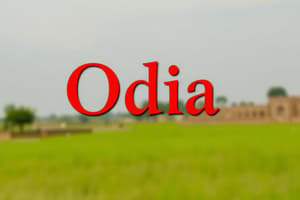Podcast
Questions and Answers
Which script is used to write Odia?
Which script is used to write Odia?
- Latin script
- Odia script (correct)
- Devanagari script
- Cyrillic script
What is the primary word order used in Odia grammar?
What is the primary word order used in Odia grammar?
- Subject-object-verb (SOV) (correct)
- Object-subject-verb (OSV)
- Verb-subject-object (VSO)
- Subject-verb-object (SVO)
What dialect of Odia is predominantly spoken in the coastal areas?
What dialect of Odia is predominantly spoken in the coastal areas?
- Maodhar
- Bolangir
- Sambalpuri
- Standard Odia (correct)
Which literary figure is known for lyrical poetry in Odia?
Which literary figure is known for lyrical poetry in Odia?
Which of the following is a significant challenge to the Odia language?
Which of the following is a significant challenge to the Odia language?
When did the earliest documents in Odia emerge?
When did the earliest documents in Odia emerge?
What is a critical aspect of Odia culture?
What is a critical aspect of Odia culture?
How many people speak Odia approximately?
How many people speak Odia approximately?
Flashcards are hidden until you start studying
Study Notes
Overview of Odia
- Odia is an Indo-Aryan language primarily spoken in the Indian state of Odisha.
- It is the official language of Odisha and is recognized as one of the classical languages of India.
Linguistic Features
- Script: Odia uses its own script, which is derived from Brahmi and is visually distinct with round shapes.
- Phonetics: The language has a rich phonetic inventory including a variety of vowels and consonants.
- Grammar: Odia grammar is characterized by its inflectional morphology, uses postpositions, and has a subject-object-verb (SOV) word order.
Historical Background
- Odia has roots dating back to the 10th century, with earliest documents in the language emerging around this time.
- The language has evolved through various historical eras, including the influence of Sanskrit and the presence of regional dialects.
Dialects
- Major dialects include:
- Standard Odia: Based on the dialect spoken in the coastal areas.
- Bolangir: Spoken in the Bolangir district.
- Sambalpuri: A distinct dialect from the western Odisha region.
Literature
- Odia has a rich literary tradition, with significant contributions in poetry, prose, and drama.
- Notable literary figures include:
- Kabi Samrat Upendra Bhanja: Renowned poet known for his lyrical poetry.
- Surendra Mohanty: Celebrated novelist and essayist.
Cultural Significance
- Odia is a key element of Odia identity and culture, often used in traditional music, dance, and festivals.
- The language plays a critical role in Odia cinema and theater.
Current Status
- Odia is spoken by over 40 million people.
- Efforts are ongoing to promote and preserve the language through education, literature, and media.
Challenges
- There are concerns regarding the preservation of the language amid increasing globalization and influence of other languages.
- Educational initiatives are critical to ensure the younger generation is proficient in Odia.
Conclusion
- Odia is a significant linguistic and cultural asset of India, with a lengthy history and vibrant contemporary usage that reflects the identity of its speakers.
Overview of Odia
- Odia is primarily spoken in the Indian state of Odisha.
- It's the official language of Odisha.
- Classified as a classical language of India.
Linguistic Features
- Odia script is derived from Brahmi and has distinct round shapes.
- It has a wide range of vowels and consonants.
- Odia grammar uses inflectional morphology, postpositions, and follows the subject-object-verb word order.
Historical Background
- Earliest Odia documents date back to the 10th century.
- The language has been influenced by Sanskrit and regional dialects.
Dialects
- The main dialects are Standard Odia spoken in coastal areas, Bolangir dialect spoken in Bolangir district, and Sambalpuri dialect from western Odisha.
Literature
- Odia literature has a rich tradition, with notable contributions in poetry, prose, and drama.
- Key literary figures include Kabi Samrat Upendra Bhanja, a renowned poet known for his lyrical poetry, and Surendra Mohanty, a celebrated novelist and essayist.
Cultural Significance
- Odia is central to Odia identity and culture, used in traditional music, dance, and festivals.
- It's prominently used in Odia cinema and theater.
Current Status
- Over 40 million people speak Odia.
- Efforts are underway to preserve and promote the language through education, literature, and media.
Challenges
- The language faces preservation challenges due to globalization and influence of other languages.
- Educational initiatives are crucial for ensuring younger generations are proficient in Odia.
Conclusion
- Odia is a significant linguistic and cultural treasure of India.
- It has a rich history and vibrant contemporary usage reflecting the identity of its speakers.
Studying That Suits You
Use AI to generate personalized quizzes and flashcards to suit your learning preferences.




